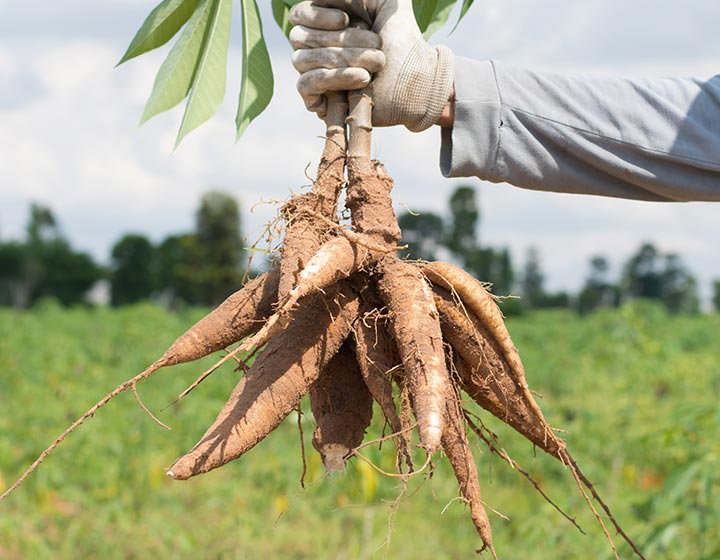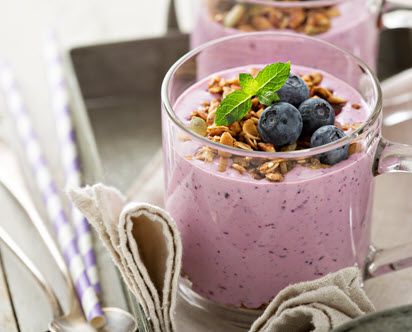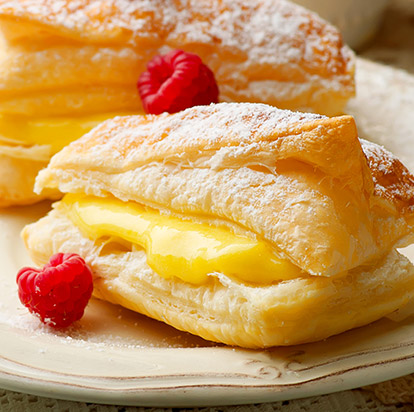
Tapioca
Unlock the potential of your products with Ingredion’s advanced tapioca solutions
Tapioca is a versatile ingredient that plays a crucial role in a wide range of food and beverage applications. From improving texture in dairy alternatives to adding stability in gluten-free baked goods, tapioca delivers a variety of benefits, including clean-label appeal, enhanced mouthfeel, and excellent shelf-life stability.
Sustainably sourced and carefully processed, Ingredion’s tapioca ingredients meet the highest standards of quality. Whether you’re seeking to reformulate for cost savings or address consumer preferences for cleaner ingredient labels and improved eating experiences, our tapioca solutions help you maintain premium product performance while meeting your business goals.

What is tapioca?
Native to South America, tapioca is derived from cassava root and used as a starch. There's no tapioca plant; instead, it's the name given to the starch extracted from the root of a cassava plant, which is widely grown in Brazil and Thailand. The plant is extremely drought resistant, making it a vital crop in global food security.
Not only is tapioca a staple food product throughout much of Africa and Asia, it also has a diverse range of applications in commercial food production across the globe. Tapioca doesn't have significant nutritional value, but it is calorie-dense and contains no gluten. It can act as an excellent wheat substitute in gluten-free, baking and as a thickening agent in other formulations as well.
In addition to meeting gluten-free standards, tapioca also meets standards for kosher, halal and vegan diets. Plus, it's non-GMO, making it an excellent ingredient to use to meet many label requirements. Tapioca can also be manufactured into a variety of textures, such as pearls, flakes or flours.
What is tapioca used for?
There are many uses for tapioca. It is an excellent texturiser with a neutral flavour profile, allowing it to be used in both sweet and savoury formulations.
In its pearl form, tapioca is commonly used in sweet treats like bubble tea (also called boba milk tea) and tapioca pudding. Both are cold, creamy desserts with chewy tapioca pearls as the star ingredient.
In its flour form, tapioca can be used as a thickening agent in soups, stews, pies, and other hot formulations. It's also popular in gluten-free baking. Pão de queijo is a Brazilian cheese bread using tapioca, which has gained popularity alongside gluten-free diets. But it's also used as a gluten-free substitute in all kinds of baked goods, either alone or mixed in with other gluten-free ingredients such as coconut flour.
Tapioca syrup is another product derived from tapioca and is a healthier alternative to corn syrup. It has no added colour and can be used as a binding agent as well as a sweetener.
Finally, tapioca is frequently used as a binding agent in a range of food products to give thickness and volume without impacting flavour. Swap out modified starch for a high-performing tapioca alternative that leaves a pleasant mouthfeel without impacting flavour.
How is tapioca made?
Tapioca is made from cassava root and is extracted in different ways depending on the final end product. To create the starch form, raw cassava root is peeled and grated. Those grated shavings are then soaked in water to create a pulp. It's then dried and used as either a starch thickener or as a flour. To make tapioca pearls, the wet pulp is formed into a dough that is then processed into small spheres.
Tapioca formulations
There are a number of tapioca products to choose from depending on your intended formulations. Ingredion offers products to address many uses for tapioca. N-DULGE® 320 starch, for instance, delivers the distinctive mochi texture with process excellence and consistent quality, allowing for more texture possibilities and process tolerance making it an effective choice for food manufacturers.
Another option is NOVATION® Indulge starches starches, Tapioca-based NOVATION® Indulge 3620 and NOVATION® Indulge 3820 functional native co-texturising starches excel in 3-in-1 hot drink mixes, soups, sauces and dairy beverages where a silky-smooth, creamy texture must be delivered. In a recent internal study comparing sensory attributes of NOVATION® Indulge 3620 and NOVATION® Indulge 3820 functional native co-texturising starches, our experts uncovered optimal usage for building back texture, managing formulation costs and more.

Here are some common products that are well-suited for tapioca:
- Soups
- Sauces
- Dressing
- Dairy desserts
- Dairy drinks
- Yoghurt
- Fruit preparations
- Baby food
What do consumers think of tapioca?
Tapioca consumption is on an upward trajectory, thanks to its health benefits and the continuing rise of gluten-free products. In fact, it's estimated that 18.4 million tons of tapioca will be sold by the end of 2032, filling in as a healthier alternative to corn starch and potato starch.
While tapioca doesn't have as much awareness among consumers as other ingredients, it can help bolster buyer sentiments by contributing to clean label standards. Tapioca is natural, gluten-free and provides a number of health benefits. Clean label ingredients (including tapioca) are expected to post a 17.5% CAGR by 2030.
This growth bodes well for food manufacturers since 71% of consumers are happy to pay more for products with natural ingredients. And 30% are willing to pay at least 20% in higher prices. Much of this recent demand has been driven by the COVID-19 pandemic as consumers are placing a higher priority on healthy foods with natural ingredients.
Food manufacturers that want to differentiate themselves from the competition while charging premium prices can tap into this market by including tapioca starch as an ingredient.

Benefits of tapioca
- Temperature stability: Tapioca is extremely stable at any temperature, including vacillating between multiple temperatures. Even if your product goes back and forth from freezing and thawing during the distribution process, tapioca maintains its proper consistency and moisture levels.
- Gluten-free and keto friendly: Tapioca can be used in just about any diet-friendly formulation. It is naturally gluten- and grain-free. Additionally, soluble tapioca starch can also be used in ketogenic food products.
- High in fibre: The resistant starch present in tapioca is high in fibre, which is a great attribute for health-conscious consumers. According to the Mayo Clinic, fibre has a number of benefits, including normalising bowel movements, lowering cholesterol levels and stabilising blood sugar levels.
- Rich in B-vitamins: Tapioca also contains B vitamins like folate (also known as vitamin B-9), which is frequently recommended as a supplement before and during pregnancy. There is also evidence showing that folate may reduce the risk of diseases such as cancer, heart disease and dementia.
- Boosts bone density: A final health benefit of tapioca is the potential for it to contribute to better bone density. The reason is because of the presence of vitamin K, iron and calcium.
Discover the versatility of tapioca

What is tapioca made from?
Tapioca is made from cassava root, which is an efficient energy-producing plant. It's grown in warm countries and doesn't need excessive rainfall in order to thrive. Ingredion uses traceable and sustainable sources to ensure maximum quality for all of our tapioca products.
Tapioca safety
Ingredion is committed to sourcing the highest quality of ingredients in all of our products. Our tapioca-based formulations never include radiation treatment, ethylene oxide, or sewage sludge. We also don't add melamine compounds, palm oil or partially hydrogenated oils in our tapioca products. This ensures the highest quality manufacturing for your products and, most importantly, your customers.
This process is especially important because cassava-based products are poisonous if consumed raw and without the proper purification process. Cyanide poisoning can occur if the cassava (and consequently, tapioca) is not soaked and dried prior to eating. It's extremely important to use reputable suppliers like Ingredion who follow safety standards to the letter.
However, one of the great things about tapioca safety is that it's allergen-friendly for so many people. People with Celiac's disease or a gluten intolerance, as well as those with nut allergies, can safely eat tapioca without worrying about any allergic reactions.
Ready to boost your brand's health labels by making the switch to tapioca?
Explore our line of tapioca products today.



